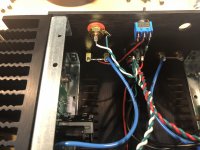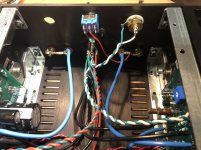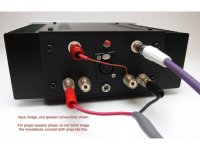Hi @tjw59. Thanks for the suggestion, I did contemplate the ML but I’m afraid I may blow it up. The ACA page on diyaudiostore.com doesn’t exactly comfort me with that idea.
It shoves my 4 ohm rated ESS speakers around with no problem. You are not going to fill an outdoor event with sound with it. However, most of the loudness your speakers are capable of producing happen at a mere watt and below. I run my 2 amps for hours and hours and hours at a time nearly 7 days a week and they just run and sound great!
The ML Motion 40 is working! The AMT is for sure better but not overly bright even with toe in Spaced 7’ apart, front baffle 3’ from rear wall and seated 9’ at the sweet spot. Room is 15x16x7. I’ll try these out for several hours.
So my ACA v1.6 monoblock build is complete and working. But one issue Monoblock operation sounds muffled?
1. Make sure that the positive of a speaker is connected to a "positive" of ACA in monoblock configuration. How to do that? I have no idea which binding post is a "positive" when ACA is used in balanced (monoblock) config, so I can't help you here. Anyway, swap the speakers' + and - and see if that improves anything.
2. Get a signal generator and an oscilloscope, and measure things... at 20Hz, 1kHz, 20kHz - use a 50W / 4 ohm and/or 8 ohms resistor, then add a bit of capacitive load and see if there are any oscillations... you can test the ACA to a certain degree where you start feeling confident its stable and ready for an expensive pair of speakers... and don't forget to do these measurements WITH the actual speaker cables you are intending to use to drive the speakers - this will take into consideration their capacitance/inductance.
Good luck,
Nick
So my ACA v1.6 monoblock build is complete and working. But one issue Monoblock operation sounds muffled? Are these meant to be only run singled ended? In an earlier thread I posted pictures of both on the bench completed and setup only for balanced operation. I tested it with a McIntosh C47 pre and Polk T15 speakers. Sounded ok but not exemplary (yes I know speakers suck but for a DIY I wasn’t about to test with more $$ units). I added the switch, resistor and wiring for single ended operation. Now I’m testing with an Onkyo preamp (SE RCA) and Polk RT 55 and both still sound the same. Lack if top end clarity and detail. Unfortunately my other speakers Totem Hawks, Kef Q150, Martin Logan Motion 40, Polk LSi25 and LSiM707 are less than 8 ohms and/or not very efficient.
Any suggestions.
Look again ad 6L6 wiring pictures. Your SE wiring with resistor is incorrect.
It is actually correct... RCA hot (white) goes to the right-hand side amp (front view of a photo). From its speaker output, there’s the red wire going to the switch and then via a drop-down resistor, to the other amp (the left-hand side amp)
So my ACA v1.6 monoblock build is complete and working. But one issue Monoblock operation sounds muffled? Are these meant to be only run singled ended? In an earlier thread I posted pictures of both on the bench completed and setup only for balanced operation. I tested it with a McIntosh C47 pre and Polk T15 speakers. Sounded ok but not exemplary (yes I know speakers suck but for a DIY I wasn’t about to test with more $$ units). I added the switch, resistor and wiring for single ended operation. Now I’m testing with an Onkyo preamp (SE RCA) and Polk RT 55 and both still sound the same. Lack if top end clarity and detail. Unfortunately my other speakers Totem Hawks, Kef Q150, Martin Logan Motion 40, Polk LSi25 and LSiM707 are less than 8 ohms and/or not very efficient.
Any suggestions.
It is difficult to see all your connections, but from the picture it looks as if you have built a 'Mirror Pair' of mono blocks? And you use the RCA inputs not the balanced option?
I assume your muffled sound is when you use them as a stereo pair of 'bridged' monos. If that is the case I see a problem...
The bottom picture (red RCA) conforms to the method posted by 6L6 in his v1.5 build instructions step 48. So looking at your picture the input goes to the left hand board and the phase inversion (resistor) goes to the right hand board input. All good so far.
Now look at the top picture (white RCA). Here you feed the input to the right hand board and invert the left hand side. Yes?
That is the problem - the white RCA mono block is out of phase with the red one. Prove it by swapping the speaker leads round on just the red mo
no block.
There is a note on the instruction to this effect by the way; ''For correct speaker phase, Do Not mirror the mono blocks. Connect both amps the same.''
Hope that improves the sucked out sound.
Alan
Attachments
Last edited:
I am pretty sure the correct in-phase connection of a speaker will also depend on how the whole XLR chain is wired and which XLR pin on ACA goes to which PCB...
a simpler solution would be just to test one speaker one way, swap + and - of that speaker, and then listen again to see if the center voices gain in focus/sound better. The worst scenario would be if one speaker is correctly wired, and the other one incorrectly... "better" scenario is if both are wired incorrectly, best is if both are wired correctly.
the much simpler way would be to play a test track specifically recorded for this purposes, downloadable from the net I'm sure...
a simpler solution would be just to test one speaker one way, swap + and - of that speaker, and then listen again to see if the center voices gain in focus/sound better. The worst scenario would be if one speaker is correctly wired, and the other one incorrectly... "better" scenario is if both are wired incorrectly, best is if both are wired correctly.
the much simpler way would be to play a test track specifically recorded for this purposes, downloadable from the net I'm sure...
I appreciate the responses. Yes I’ve built them as a symmetrical mirror pair and yes I had them running initially as a balanced only monoblock. I added the single ended RCA as an option and the sound is still the same. I’m fairly certain it’s not out of phase and canceling each other out. The sound presentation is fairly laid back on the mid and top end. Bass is fairly strong. The AMT tweeter is helping bring the top end more forward.
Check out my initial post on post #5065l. I kept the XLR monoblock wiring the same I only inverted the board location and +/- speaker outputs. So naturally wiring the RCA I also needed to invert the location and hookup and powered the RED input board with the output from the white input board.
It’s quite possible I’m not used to the sound of a class A amp. I’ve read the ACA in SE operation is supposed to have a warm tubey sound. All of my other amps, Rotel, Marantz, McIntosh and Sansui are all SS class AB and brighter.
Check out my initial post on post #5065l. I kept the XLR monoblock wiring the same I only inverted the board location and +/- speaker outputs. So naturally wiring the RCA I also needed to invert the location and hookup and powered the RED input board with the output from the white input board.
It’s quite possible I’m not used to the sound of a class A amp. I’ve read the ACA in SE operation is supposed to have a warm tubey sound. All of my other amps, Rotel, Marantz, McIntosh and Sansui are all SS class AB and brighter.
Last edited:
Hi Guys,
One small question.
ACA output power is approximately 5Watt.
Seas Prestige FU10RB-H1600-04 4" Full Range sensitivity is 85dB.
at 4 meters distance is ACA capable of producing medium ( I mean I can talk to my friend while listening to music) sound. or is ACA too low ?.
Thanks,
Nag.
One small question.
ACA output power is approximately 5Watt.
Seas Prestige FU10RB-H1600-04 4" Full Range sensitivity is 85dB.
at 4 meters distance is ACA capable of producing medium ( I mean I can talk to my friend while listening to music) sound. or is ACA too low ?.
Thanks,
Nag.
Have you measured that your preamp is able to bring the ACA to clipping (and that it clips at …...maybe 8 - 10 V peak or so?
It is best to test the amp first using a 8 ohm resistor and then measure both input and output to check that the amp behaves as it should.
I would say that the ACA should be able to play louder…..than just "background music" in 85 dB speakers.
It is best to test the amp first using a 8 ohm resistor and then measure both input and output to check that the amp behaves as it should.
I would say that the ACA should be able to play louder…..than just "background music" in 85 dB speakers.
Pass DIY Addict
Joined 2000
Paid Member
2. Get a signal generator and an oscilloscope, and measure things... at 20Hz, 1kHz, 20kHz - use a 50W / 4 ohm and/or 8 ohms resistor, then add a bit of capacitive load and see if there are any oscillations...
All of the testing I've done like this used only a resistive load. Is the cap added in series or parallel to the resistor? What are typical values of capacitance that should/should not cause trouble for the typical Pass clone?
Eric
Yes I’ve built them as a symmetrical mirror pair and yes I had them running initially as a balanced only monoblock. I added the single ended RCA as an option and the sound is still the same. I’m fairly certain it’s not out of phase and cancelling each other out. The sound presentation is fairly laid back on the mid and top end. Bass is fairly strong. The AMT tweeter is helping bring the top end more forward.
It’s quite possible I’m not used to the sound of a class A amp. I’ve read the ACA in SE operation is supposed to have a warm tubey sound. All of my other amps, Rotel, Marantz, McIntosh and Sansui are all SS class AB and brighter.
Thanks, yes I am in the same place as you now. The RCA / resistor inversion is irrelevant if you use the balanced input.
It was your description of the muffled sound quality that started me (and others) thinking. My perception of their sound is different to yours - I feel they just lack a little detail generally, but hold up well compared to most low power SE valve amplifiers...
Alan
My perception of their sound is different to yours - I feel they just lack a little detail generally, but hold up well compared to most low power SE valve amplifiers...
Alan
I agree as a general statement perception of sound is different for everyone. I also agree the ACA lack a little detail. For reference I have to listen closely for the details where as in a more revealing system I can hear there naturally.
As others have suggested I need to put my built up pair on a scope and measure them to make sure there wasn't any user error. Run in mono each sound exactly the same and both only run as mono blocks, I haven't tested SE operation to see if its sound character is very different.
You could try the ACAs in pure SE mode. You get lower output impedance so better drive capability if you can live with lower max. output power. You could also experiment with MKP input capacitor and low ESR / low inductive output capacitor. I did that and I find the ACA very detailed. I did not test with the original capacitors so can't comment on the sound difference but I compared objective measurement using a pro LCR bridge and the capacitors I use showed much better figures like ESR, loss factor etc. It was first after I used a real preamp with some gain the ACA showed what it can do.
a simpler solution would be just to test one speaker one way, swap + and - of that speaker, and then listen again to see if the center voices gain in focus/sound better. The worst scenario would be if one speaker is correctly wired, and the other one incorrectly... "better" scenario is if both are wired incorrectly, best is if both are wired correctly.
Given that absolute phase — if it exists on the SW — changes from album to album, this has to be done for each disk anyway. Obsession with absolute phase requires a phase switch.
dave
Mounting Guide Link
Hi all, found this mounting guide for power resistors. Good luck with your Build.
http://www.rcdcomponents.com/rcd/pr...ines for RCD Leaded Resistors & Inductors.pdf
Moto
Thanks everyone for the 3,300uF cap diameter size info.
With the resistor, I bend its legs, insert both ends into PCB eyelets, hold the resistor body with my fingers while soldering only one leg. Then I inspect the "height" - how far from the PCB it is...
If I'm not happy with the distance, only one leg needs to be heated-up to readjust the height... once happy, I solder the other leg.
This works as long as you don't hold the resistor legs with your fingers... 🙂 Of course, this will also allow you to solder one resistor at the time, but there will be no need for any readjustments latter.... and the resistors will be perfectly parallel to the PCB plane, for that visual perfection/satisfaction.
Hi all, found this mounting guide for power resistors. Good luck with your Build.
http://www.rcdcomponents.com/rcd/pr...ines for RCD Leaded Resistors & Inductors.pdf
Moto
Hmm - I built the first amplifier, taking my time - and now it's time to set the bias. But I'm getting a weird power supply / current draw issue. Starts at ~24VDC, holds it for a few seconds, and then the current draw is enough that it bogs down to ~5VDC. And fluctuates back and forth, making the LEDs turn off and on like a Christmas tree light.
*sigh* too late to do any troubleshooting.
*sigh* too late to do any troubleshooting.
Does anyone know what size male dc barrel end is needed for a proper connection to the female barrel plug that is included with the ACA kit? I tried searching for it but no luck.
Actually I might of spoken too soon. Can anyone confirm if this is the correct size 5.5/2.1mm Coaxial power plug, cable end | MPJA.COM
Hmm - I built the first amplifier, taking my time - and now it's time to set the bias. But I'm getting a weird power supply / current draw issue. Starts at ~24VDC, holds it for a few seconds, and then the current draw is enough that it bogs down to ~5VDC. And fluctuates back and forth, making the LEDs turn off and on like a Christmas tree light.
*sigh* too late to do any troubleshooting.
1. Check the power supply connection at ACA back panel, make sure it is a good connection that can sustain constant current draw of around 3-3.5A (!)
2. Try a different power supply
- 2a) what you described is a typical SMPS short-circuit protection behaviour (due to a short between heatsinks and MOSFETS?), or some other wiring problem(s)...?
- 2b) the SMPS might be faulty - if the switching circuitry cannot achieve the rated switching frequency (at high voltage side...)
There is "bulb testers" info on Pass forums; try that as well
...If you have an auto-transformer, tone generator and oscilloscope, you'll be able to pinpoint the root cause fairly quickly.
Good luck, let us know what the problem was once you fix it.
- Home
- Amplifiers
- Pass Labs
- Amp Camp Amp - ACA


